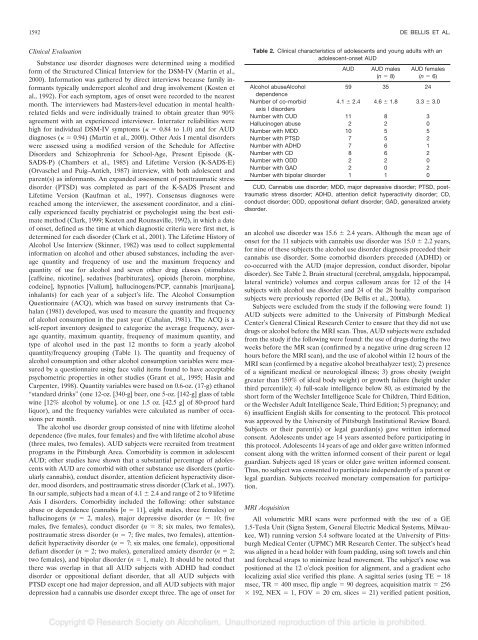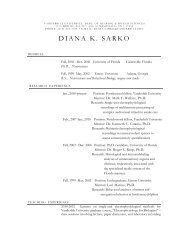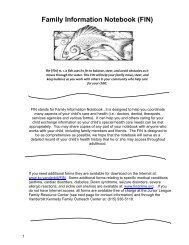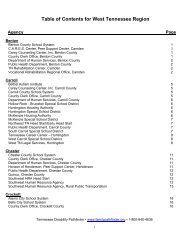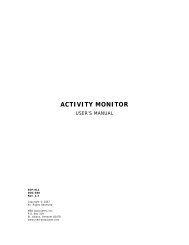Prefrontal Cortex, Thalamus, and Cerebellar Volumes in ...
Prefrontal Cortex, Thalamus, and Cerebellar Volumes in ...
Prefrontal Cortex, Thalamus, and Cerebellar Volumes in ...
Create successful ePaper yourself
Turn your PDF publications into a flip-book with our unique Google optimized e-Paper software.
1592 DE BELLIS ET AL.<br />
Cl<strong>in</strong>ical Evaluation<br />
Substance use disorder diagnoses were determ<strong>in</strong>ed us<strong>in</strong>g a modified<br />
form of the Structured Cl<strong>in</strong>ical Interview for the DSM-IV (Mart<strong>in</strong> et al.,<br />
2000). Information was gathered by direct <strong>in</strong>terviews because family <strong>in</strong>formants<br />
typically underreport alcohol <strong>and</strong> drug <strong>in</strong>volvement (Kosten et<br />
al., 1992). For each symptom, ages of onset were recorded to the nearest<br />
month. The <strong>in</strong>terviewers had Masters-level education <strong>in</strong> mental healthrelated<br />
fields <strong>and</strong> were <strong>in</strong>dividually tra<strong>in</strong>ed to obta<strong>in</strong> greater than 90%<br />
agreement with an experienced <strong>in</strong>terviewer. Interrater reliabilities were<br />
high for <strong>in</strong>dividual DSM-IV symptoms (� � 0.84 to 1.0) <strong>and</strong> for AUD<br />
diagnoses (� � 0.94) (Mart<strong>in</strong> et al., 2000). Other Axis I mental disorders<br />
were assessed us<strong>in</strong>g a modified version of the Schedule for Affective<br />
Disorders <strong>and</strong> Schizophrenia for School-Age, Present Episode (K-<br />
SADS-P) (Chambers et al., 1985) <strong>and</strong> Lifetime Version (K-SADS-E)<br />
(Orvaschel <strong>and</strong> Puig–Antich, 1987) <strong>in</strong>terview, with both adolescent <strong>and</strong><br />
parent(s) as <strong>in</strong>formants. An exp<strong>and</strong>ed assessment of posttraumatic stress<br />
disorder (PTSD) was completed as part of the K-SADS Present <strong>and</strong><br />
Lifetime Version (Kaufman et al., 1997). Consensus diagnoses were<br />
reached among the <strong>in</strong>terviewer, the assessment coord<strong>in</strong>ator, <strong>and</strong> a cl<strong>in</strong>ically<br />
experienced faculty psychiatrist or psychologist us<strong>in</strong>g the best estimate<br />
method (Clark, 1999; Kosten <strong>and</strong> Rounsaville, 1992), <strong>in</strong> which a date<br />
of onset, def<strong>in</strong>ed as the time at which diagnostic criteria were first met, is<br />
determ<strong>in</strong>ed for each disorder (Clark et al., 2001). The Lifetime History of<br />
Alcohol Use Interview (Sk<strong>in</strong>ner, 1982) was used to collect supplemental<br />
<strong>in</strong>formation on alcohol <strong>and</strong> other abused substances, <strong>in</strong>clud<strong>in</strong>g the average<br />
quantity <strong>and</strong> frequency of use <strong>and</strong> the maximum frequency <strong>and</strong><br />
quantity of use for alcohol <strong>and</strong> seven other drug classes (stimulates<br />
[caffe<strong>in</strong>e, nicot<strong>in</strong>e], sedatives [barbiturates], opioids [hero<strong>in</strong>, morph<strong>in</strong>e,<br />
code<strong>in</strong>e], hypnotics [Valium], halluc<strong>in</strong>ogens/PCP, cannabis [marijuana],<br />
<strong>in</strong>halants) for each year of a subject’s life. The Alcohol Consumption<br />
Questionnaire (ACQ), which was based on survey <strong>in</strong>struments that Cahalan<br />
(1981) developed, was used to measure the quantity <strong>and</strong> frequency<br />
of alcohol consumption <strong>in</strong> the past year (Cahalan, 1981). The ACQ is a<br />
self-report <strong>in</strong>ventory designed to categorize the average frequency, average<br />
quantity, maximum quantity, frequency of maximum quantity, <strong>and</strong><br />
type of alcohol used <strong>in</strong> the past 12 months to form a yearly alcohol<br />
quantity/frequency group<strong>in</strong>g (Table 1). The quantity <strong>and</strong> frequency of<br />
alcohol consumption <strong>and</strong> other alcohol consumption variables were measured<br />
by a questionnaire us<strong>in</strong>g face valid items found to have acceptable<br />
psychometric properties <strong>in</strong> other studies (Grant et al., 1995; Has<strong>in</strong> <strong>and</strong><br />
Carpenter, 1998). Quantity variables were based on 0.6-oz. (17-g) ethanol<br />
“st<strong>and</strong>ard dr<strong>in</strong>ks” (one 12-oz. [340-g] beer, one 5-oz. [142-g] glass of table<br />
w<strong>in</strong>e [12% alcohol by volume], or one 1.5 oz. [42.5 g] of 80-proof hard<br />
liquor), <strong>and</strong> the frequency variables were calculated as number of occasions<br />
per month.<br />
The alcohol use disorder group consisted of n<strong>in</strong>e with lifetime alcohol<br />
dependence (five males, four females) <strong>and</strong> five with lifetime alcohol abuse<br />
(three males, two females). AUD subjects were recruited from treatment<br />
programs <strong>in</strong> the Pittsburgh Area. Comorbidity is common <strong>in</strong> adolescent<br />
AUD; other studies have shown that a substantial percentage of adolescents<br />
with AUD are comorbid with other substance use disorders (particularly<br />
cannabis), conduct disorder, attention deficient hyperactivity disorder,<br />
mood disorders, <strong>and</strong> posttraumatic stress disorder (Clark et al., 1997).<br />
In our sample, subjects had a mean of 4.1 � 2.4 <strong>and</strong> range of 2 to 9 lifetime<br />
Axis I disorders. Comorbidity <strong>in</strong>cluded the follow<strong>in</strong>g: other substance<br />
abuse or dependence (cannabis [n � 11], eight males, three females) or<br />
halluc<strong>in</strong>ogens (n � 2, males), major depressive disorder (n � 10; five<br />
males, five females), conduct disorder (n � 8; six males, two females),<br />
posttraumatic stress disorder (n � 7; five males, two females), attentiondeficit<br />
hyperactivity disorder (n � 7; six males, one female), oppositional<br />
defiant disorder (n � 2; two males), generalized anxiety disorder (n � 2;<br />
two females), <strong>and</strong> bipolar disorder (n � 1, male). It should be noted that<br />
there was overlap <strong>in</strong> that all AUD subjects with ADHD had conduct<br />
disorder or oppositional defiant disorder, that all AUD subjects with<br />
PTSD except one had major depression, <strong>and</strong> all AUD subjects with major<br />
depression had a cannabis use disorder except three. The age of onset for<br />
Table 2. Cl<strong>in</strong>ical characteristics of adolescents <strong>and</strong> young adults with an<br />
adolescent-onset AUD<br />
AUD AUD males<br />
(n � 8)<br />
AUD females<br />
(n � 6)<br />
Alcohol abuseAlcohol<br />
dependence<br />
59 35 24<br />
Number of co-morbid<br />
axis I disorders<br />
4.1 � 2.4 4.6 � 1.8 3.3 � 3.0<br />
Number with CUD 11 8 3<br />
Halluc<strong>in</strong>ogen abuse 2 2 0<br />
Number with MDD 10 5 5<br />
Number with PTSD 7 5 2<br />
Number with ADHD 7 6 1<br />
Number with CD 8 6 2<br />
Number with ODD 2 2 0<br />
Number with GAD 2 0 2<br />
Number with bipolar disorder 1 1 0<br />
CUD, Cannabis use disorder; MDD, major depressive disorder; PTSD, posttraumatic<br />
stress disorder; ADHD, attention deficit hyperactivity disorder; CD,<br />
conduct disorder; ODD, oppositional defiant disorder; GAD, generalized anxiety<br />
disorder.<br />
an alcohol use disorder was 15.6 � 2.4 years. Although the mean age of<br />
onset for the 11 subjects with cannabis use disorder was 15.0 � 2.2 years,<br />
for n<strong>in</strong>e of these subjects the alcohol use disorder diagnosis preceded their<br />
cannabis use disorder. Some comorbid disorders preceded (ADHD) or<br />
co-occurred with the AUD (major depression, conduct disorder, bipolar<br />
disorder). See Table 2. Bra<strong>in</strong> structural (cerebral, amygdala, hippocampal,<br />
lateral ventricle) volumes <strong>and</strong> corpus callosum areas for 12 of the 14<br />
subjects with alcohol use disorder <strong>and</strong> 24 of the 28 healthy comparison<br />
subjects were previously reported (De Bellis et al., 2000a).<br />
Subjects were excluded from the study if the follow<strong>in</strong>g were found: 1)<br />
AUD subjects were admitted to the University of Pittsburgh Medical<br />
Center’s General Cl<strong>in</strong>ical Research Center to ensure that they did not use<br />
drugs or alcohol before the MRI scan. Thus, AUD subjects were excluded<br />
from the study if the follow<strong>in</strong>g were found: the use of drugs dur<strong>in</strong>g the two<br />
weeks before the MR scan (confirmed by a negative ur<strong>in</strong>e drug screen 12<br />
hours before the MRI scan), <strong>and</strong> the use of alcohol with<strong>in</strong> 12 hours of the<br />
MRI scan (confirmed by a negative alcohol breathalyzer test); 2) presence<br />
of a significant medical or neurological illness; 3) gross obesity (weight<br />
greater than 150% of ideal body weight) or growth failure (height under<br />
third percentile); 4) full-scale <strong>in</strong>telligence below 80, as estimated by the<br />
short form of the Wechsler Intelligence Scale for Children, Third Edition,<br />
or the Wechsler Adult Intelligence Scale, Third Edition; 5) pregnancy; <strong>and</strong><br />
6) <strong>in</strong>sufficient English skills for consent<strong>in</strong>g to the protocol. This protocol<br />
was approved by the University of Pittsburgh Institutional Review Board.<br />
Subjects or their parent(s) or legal guardian(s) gave written <strong>in</strong>formed<br />
consent. Adolescents under age 14 years assented before participat<strong>in</strong>g <strong>in</strong><br />
this protocol. Adolescents 14 years of age <strong>and</strong> older gave written <strong>in</strong>formed<br />
consent along with the written <strong>in</strong>formed consent of their parent or legal<br />
guardian. Subjects aged 18 years or older gave written <strong>in</strong>formed consent.<br />
Thus, no subject was consented to participate <strong>in</strong>dependently of a parent or<br />
legal guardian. Subjects received monetary compensation for participation.<br />
MRI Acquisition<br />
All volumetric MRI scans were performed with the use of a GE<br />
1.5-Tesla Unit (Signa System, General Electric Medical Systems, Milwaukee,<br />
WI) runn<strong>in</strong>g version 5.4 software located at the University of Pittsburgh<br />
Medical Center (UPMC) MR Research Center. The subject’s head<br />
was aligned <strong>in</strong> a head holder with foam padd<strong>in</strong>g, us<strong>in</strong>g soft towels <strong>and</strong> ch<strong>in</strong><br />
<strong>and</strong> forehead straps to m<strong>in</strong>imize head movement. The subject’s nose was<br />
positioned at the 12 o’clock position for alignment, <strong>and</strong> a gradient echo<br />
localiz<strong>in</strong>g axial slice verified this plane. A sagittal series (us<strong>in</strong>g TE � 18<br />
msec, TR � 400 msec, flip angle � 90 degrees, acquisition matrix � 256<br />
� 192, NEX � 1, FOV � 20 cm, slices � 21) verified patient position,


